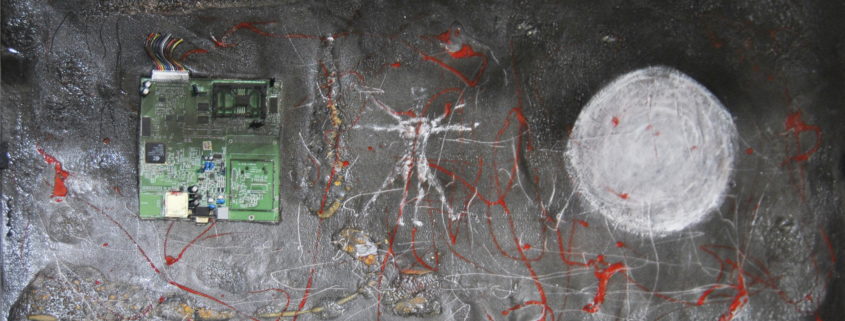Il Nuovo Vitruviano di Andrea Renda
Il Nuovo Vitruviano di Andrea Renda
A misura d’Uomo
L’”Uomo vitruviano” è il celeberrimo disegno di Leonardo realizzato alla fine del XV secolo, noto anche come “Le proporzioni del corpo umano secondo Vitruvio“. Il disegno rappresenta il corpo nudo di un uomo con quattro gambe e quattro braccia inscritto all’interno di un quadrato e di un cerchio. L’architetto romano Vitruvio nel suo trattato “De Architectura” pone l’attenzione allo studio delle proporzioni. Così come una perfetta architettura, anche una perfetta figura umana avrà le misure delle varie parti del corpo conformi a canoni precisi di armonia, che Vitruvio definisce e che Leonardo ricorda nelle note del suo disegno.
L’Uomo Vitruviano è quindi una ricerca sulle proporzioni ideali del corpo umano, ma è anche molto di più. La figura di Leonardo pone l’uomo al centro dell’Universo e sintetizza il pensiero che l’uomo sia la “misura di tutte le cose”, del tempo e dello spazio.
“l’omo è detto dalli antiqui mondo minore”: una teoria secondo la quale l’uomo è il riflesso di un ordine superiore, un microcosmo che racchiude in se tutti gli elementi che compongono l’universo. Il cerchio e il quadrato possono leggersi in chiave simbolica: il quadrato rappresenta il mondo terreno e il cerchio l’universo, la sfera divina. L’uomo rappresenta l’elemento di raccordo tra i due mondi, una creatura che è riflesso dell’uno e dell’altro. Cerchio e quadrato possono sovrapporsi? Leonardo attraverso le misure vitruviane affronta la problematica del rapporto tra umano e divino e la relazione dell’uomo con il tutto, la sua posizione nel mondo in rapporto alla sfera celeste. Una problematica universale e trasversale nel tempo e che rende questa immagine così attuale, una icona che ancora oggi esprime i nostri dubbi, le nostre ansie, la nostra voglia di essere al centro dell’universo e lo sgomento per questo scomodo ruolo.
Un ruolo sul quale ora riflette il Nuovo Vitruviano.
Mediatore, vede scollarsi l’armonia tra sfera celeste e sfera terrena, tra le leggi dell’universo e le nuove artificiose leggi in perpetuo dinamismo.
Padrone del proprio destino, sfida le leggi universali per dettare le proprie.
Lontano dal divino, si sgomenta della realtà artificiale che egli stesso ha creato. Non si riconosce e cerca il suo ruolo tra cerchio e quadrato che si allontanano sempre più. Ancora al centro della questione, il nuovo vitruviano cerca invano la quadratura del cerchio.
Maria Teresa Majoli
On a human scale
The “Vitruvian Man” is the famous drawing by Leonardo made at the end of the fifteenth century, also known as “The proportions of the human body according to Vitruvius”. The drawing represents the naked body of a man with four legs and four arms inscribed inside a square and a circle. The Roman architect Vitruvius in his treatise “De Architectura” focuses on the study of proportions.
As well as a perfect architecture, even a perfect human figure will have the measures of the various parts of the body conforming to precise canons of harmony, which Vitruvius defines and which Leonardo remembers in the notes of his drawing.
The Vitruvian Man is therefore a research on the ideal proportions of the human body, but it is also much more. The figure of Leonardo places man at the center of the Universe and synthesizes the thought that man is the “measure of all things”, of time and space.
“l’omo è detto dalli antiqui mondo minore”:(The man is said by the antiqui minor world: a theory according to which man is the reflection of a higher order, a microcosm that contains all the elements that make up the universe. The circle and the square can be read in a symbolic key: the square represents the earthly world and the circle the universe, the divine sphere. Man represents the element of connection between the two worlds, a creature that is a reflection of both.
Circle and square can overlap? Leonardo, through the Vitruvian measures, deals with the problematic of the relationship between human and divine and the relationship of man with the whole, his position in the world in relation to the celestial sphere. A universal and transversal problem in time that makes this image so current, an icon that still today expresses our doubts, our anxieties, our desire to be at the center of the universe and the dismay for this uncomfortable role.
A role on which the New Vitruvian now reflects.
As a Mediator, he sees the harmony between the celestial sphere and the earthly sphere slip between the laws of the universe and the new artificial laws in perpetual dynamism.
As Master of his own destiny, he defies universal laws to dictate his own.
Far from the divine, he is dismayed by the artificial reality that he himself has created. It does not recognize and seeks its role between the circle and the square that move away from each other more and more. Still at the center of the question, the New Vitruvian seeks in vain to square the circle.




